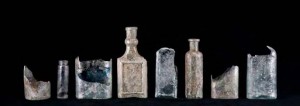Waite-Kirby-Potter House
Documentary Research and Archaeological Investigations
at the Waite-Kirby-Potter Site,
Westport, Massachusetts
Prepared for:
The Community Preservation Committee
Town of Westport, Massachusetts
Prepared by:
Katharine M. Johnson and Christa M. Beranek
With contributions by Kathryn A. Catlin and Laura W. Ng
Fiske Center for Archaeological Research
University of Massachusetts Boston
Cultural Resource Management Study No. 37
May 2010
Begin reading immediately by clicking here.
ABSTRACT
Research on the Waite-Kirby-Potter house in Westport, Massachusetts, included mapping historical resources visible on the surface and excavating 25 test pits and units near the house foundations in the fall of 2009. Field investigations were complemented by extensive documentary research including a complete chain of title and genealogical research on the three families who have owned the property between the late 17th century and the present. The visible historical features include elements associated with the former stone ender (the standing stone end and chimney, an adjacent brick chimney, and a stone-lined cellar hole), stone walls, a 19th-century barn foundation, a family cemetery, and the standing Restcome Potter house. The excavations uncovered a clean gravel work yard in front of the stone end house and sheet trash scatters with artifacts from the mid-18th to early 20th centuries behind
and west of the house, as well as the remains of post holes for an agricultural outbuilding or fence at the edge of the near-by agricultural field. A primary trash deposit from a space within the chimney complex was probably deposited c. 1860 and contained numerous reconstructable ceramic vessels and glass bottles. Several of the ceramic vessels date to the previous century and had been curated for some time before being discarded.
The most significant contributions are to the architectural history of the property; the combination of archaeological and documentary research has suggested some new or more specific dates for events previously dated only by tradition. We suggest that the stone-end house, traditionally dated to 1677, may have been constructed in the early 18th century between 1707 and 1721
by Thomas or Benjamin Waite. The western addition to the house, attributed to David Kirby, was constructed during the period when David and his father Ichabod’s families both occupied the house (1763-1793). The construction of the Restcome Potter house has traditionally been attributed to Restcome in 1838, but the property’s previous owner David Kirby mentions his “new dwelling house” in his 1832 will, pushing the construction date of this house earlier. Finally, the modifications to the stone chimney took place after 1858, demonstrating the Potter family’s continued use and upkeep of the older house. Test pits around the foundations of the western addition to the stone ender uncovered stone foundations and sill supports intact immediately beneath the modern ground surface.
ACKNOWLEDGEMENTS
Anne (Pete) Baker of Westport has been a long-time advocate for historic buildings in Westport and for the Waite-Kirby-Potter site in particular. We would like to thank her for integrating archaeological research into this project and for applying for the funding that supported this work. The funding came from the Community Preservation Committee of the Town of Westport, and we thank them for their support. We would also like to acknowledge the field crew: Michael Way, Heidi Krofft, Kate Descoteaux, Kelly Ferguson, Kathryn Catlin, and David Landon of UMass Boston, and volunteers Jesse Daubert and Perry Rushton of the Public Archaeology Laboratory. Artifact photographs were taken by Melody Henkel of UMass Boston. Kate Descoteaux assisted with the documentary research, and Anna Hayden processed and cataloged many of the artifacts. Jenny O’Neill of the Westport Historical Society helped to locate many documents used in this report. Finally, Muriel Bibeau, the property owner and descendant of the Potter family, graciously allowed us to conducted excavations on her lawn and shared the oral history and photographs of her family with us. This project would not have been possible without her generosity.
WHS NOTE
For the sake of clarity, this online document has been edited, though every attempt has been made to render the original text intact. Where further explanation is deemed beneficial, an editor’s note will identify it as separate and distinct from the original document. A downloadable pdf of the entire research report is available here.

